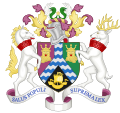| Sydenham Wells Park | |
|---|---|
 Sydenham Wells Park is named after medicinal springs | |
 | |
| Type | Public park |
| Location | Upper Sydenham |
| Coordinates | 51°25′43″N0°04′06″W / 51.428728°N 0.068342°W |
| Created | 1901 |
| Operated by | Glendale |
| Status | Open |
| Website | Sydenham Wells Park |
Sydenham Wells Park is located in Sydenham, south east London. It includes parks and fields. The park is owned by the London Borough of Lewisham and maintained by Glendale. Wells Park is named after medicinal springs which were found in Sydenham in the seventeenth century, when Sydenham was still in Kent. This attracted crowds of people to the area. Some of the former wells in the area are within the park's grounds and the springs are still active. [1] In 1901 the park was opened to the public and is one of nine parks in the borough to have a Green flag award. [2] [3] Open times vary throughout the year. [4]


